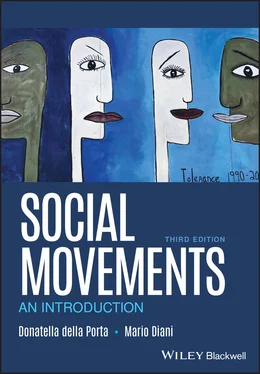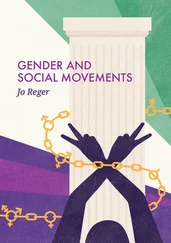1 ...6 7 8 10 11 12 ...28 To these variables others have been added, relating to the institutional conditions that regulate agenda‐setting and decision‐making processes. Characteristics relating to the functional division of power and also to geographical decentralization have been analyzed in order to understand the origins of protest and the forms it has taken. In general, the aim has been to observe which stable or ‘mobile’ characteristics of the political system influence the growth of less institutionalized political action in the course of what are defined as protest cycles (Tarrow 1989), as well as the forms these actions take in different historical contexts (Tilly 1978). The comparison between different political systems (for some pioneering works, see Kitschelt 1986; Kriesi et al. 1995; della Porta 1995) enabled the central theme of relationships between social movements and the institutional political system to be studied in depth.
The political process approach succeeded in shifting attention toward interactions between new and traditional actors, and between less conventional forms of action and institutionalized systems of interest representation. In this way, it is no longer possible to define movements as phenomena that are, of necessity, marginal and anti‐institutional, expressions of dysfunctions of the system. A more fruitful route toward the interpretation of the political dimension of contemporary movements has been established.
One should not ignore, however, some persisting areas of difficulty. On the one hand, supporters of this perspective continue to debate delicate problems such as the choice of the most appropriate indicators to measure complex institutional phenomena. First, the lack of consensus on the relevant dimensions of the concept of political opportunities resulted in their exponential growth. Early studies of political opportunities focused on a small number of variables. Since the 1980s, however, the addition of new variables to the original set has expanded the explanatory power of the concept, but reduced its specificity. The concept runs the risk of becoming a ‘dustbin’ for any and every variable relevant to the development of social movements. Most of the concept’s problems arise from the way in which it has been developed, picking up variables from a variety of studies on a variety of movements. This accumulation of heterogeneous variables reflecting different authors’ concerns and ideas has resulted in a concept which, to quote Sartori (1970), denotes much but connotes little. Particularly in international comparative studies, it is impossible to handle the large number of variables and assess properly their explanatory power. Focus on structural variables might shift attention away from how norms and values, referring in particular to movements goals (or discursive opportunities), influence movement strategies as well as their chances of success (Goodwin 2011; Goodwin and Jasper 1999; Jasper 2018).
A second problem arises when we wish to distinguish between ‘objective’ reality and its social construction (Berger and Luckmann 1969). Some changes in the political opportunity structure do not have any effect on a social movement unless they are perceived as important by the movement itself. Structural availability must be filtered through a process of ‘cognitive liberation’ in order to unleash turmoil (McAdam 1986). For protest to emerge, activists must believe that an opportunity exists, that they have the power to bring about change and they must blame the system for the problem. Looking at structural opportunities without considering the cognitive processes that intervene between structure and action can be very misleading. It is important, therefore, to analyze activists’ understandings of available opportunities, the lenses through which they view potential opportunities for their movements (Gamson and Meyer 1996). Perceptions of state response may be particularly influenced, for instance, by its more dramatic manifestations, such as repression, causing the less visible responses, such as negotiation, to be overlooked.
The political process approach has also been criticized externally for its tendency to adopt a kind of “political reductionism” (Melucci 1987, 1989). In effect, its proponents have paid little attention to the fact that many contemporary movements (of youth, women, homosexuals or minority ethnic groups) have developed within a political context and in a climate of cultural innovation at the same time (Melucci 1996; Rupp and Taylor 1987). Lastly – as we have already noted when introducing resource mobilization theories – rationalist approaches to the study of collective action have tended to neglect the structural origins of protest. Other scholars, often associated with the new movements approach, have long pointed at this limit, by raising attention to the cultural dimension, while more recently Marxist approaches have returned upon the relevance of the interaction between the state and the market within the evolution of capitalism (Barker et al. 2014; della Porta 2015a). Within this perspective, in a moment in which movements tend to proliferate even with a closing down of political opportunities, attention went to the role of socioeconomic threats as triggers for collective action (ibid.).
Faced with some relevant transformations in the two main sources of opportunities for movements – the nation‐state and the political parties – research developed in two main directions. On the one hand, and especially in Europe, attention focused on the role played by movements, not just within the political system, but also within the public sphere. In this direction, the discursive opportunities – i.e., the presence of dominant public discourses on certain controversial issues, which are likely to affect movements’ chances of success – have been stressed (Koopmans and Statham 1999). Moreover, more and more attention has been paid to transnational opportunities, or, better said, to a multilevel opportunity structure for movements (della Porta and Tarrow 2005). The development of the European Union as an arena for movement demands has been discussed more in depth (della Porta and Caiani 2009). Considering movements as part and parcel of the political system, an increasing number of studies has also focused on their effects, especially in terms of policy process and policy decisions (Bosi, Giugni, and Uba 2015). What is more, while social movements had been traditionally considered as ‘strangers at the gate’ of the political system (Tarrow 2012), in the turmoil of the Great Regression, social movements have been very effective in penetrating electoral politics through referendums from below as well as the proliferation of movements’ parties (della Porta, O’Connor et al. 2017; della Porta, Fernandez et al. 2017).
1.1.5 Are These Questions Specific to Social Movement Analysis?
In this book we shall address these different questions: the social determinants of protest ( chapter 2), the role of cultural and symbolic elements ( chapters 3– 4), the organizational dynamics ( chapters 5– 6), and the political context for and effects of movements ( chapters 7– 9). But, before doing that, we still have to discuss whether the questions – and the responses – identified above are peculiar to social movement research. In many cases, these questions address not just social movements but collective action more in general. Collective action broadly refers to individuals, sharing resources in pursuit of collective goods – i.e., goods that cannot be privatized and subtracted to any of the members of the collectivity on behalf of which collective action has taken place. Such goods may be produced within movements, but also in many contexts that normally are not associated with movements. In our notion, the idea of ‘collective goods’ comprises both public goods à la Olson and club goods. For Samuelson (1954), the key characteristics of public goods are non‐excludability, and nonrivalrous consumption (i.e., no scarcity once the good is produced). A club good is nonexcludable for club members but excludable for outsiders, possibly (but not necessarily) non‐rivalrous for those with access (Buchanan 1965).
Читать дальше












